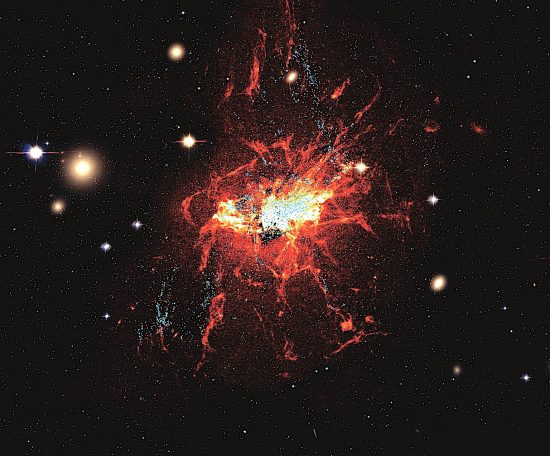
July 10, 2020
A lightning bolt is accompanied by a transverse electric discharge.
On Earth, slow-motion video reveals that each lightning flash is a complex event. Multiple leader strokes descend from the clouds, while similar, less visible potential contacts rise from the ground. Once two points of contact are made, the energy stored in the cloud-to-ground capacitor discharges, drawing current from several square kilometers.
A capacitor is used to accumulate and store electric charge. Capacitors are usually made of two conductors separated by an insulating medium, or dielectric insulator. An electric charge on one conductor attracts an opposite charge to the other conductor, resulting in an electric field between them that acts as an electrical energy reserve.
As charges inside a capacitor increase, its electric field increases, stressing the insulator’s ability to keep them separate. If a high enough potential grows between its two conductive plates, the dielectric insulator will fail and the capacitor will short circuit, suddenly releasing its stored energy.
It is that phenomenon that most likely contributes to lightning discharges. Stored electrical energy in the clouds and in the ground overcome the atmosphere’s ability to keep the two charges separate, so they reach out to each other in the form of “leader strokes.” When the two lightning leaders meet, a circuit between the clouds and the ground (or between one cloud and another) is completed and a burst of electricity flashes along the conductive pathway.
Cloud-to-surface lightning is accompanied by transverse or “corona discharges” at right angles to the main channel. They appear to be “tributaries” joining the primary discharge. Surface lightning forces close tributaries to be parallel because of electromagnetic forces between them. Brachiated burns or cuts in various materials at different scales are sometimes called “Lichtenberg figures”.
Lichtenberg figures are named after Georg Christoph Lichtenberg. They form when lightning bolts strike some material on Earth – it can be soil or even human tissue. They have also been artificially generated in blocks of acrylic plastic. Many Lichtenberg figures have been discovered in the south polar region of Mars.
Plasma discharges can produce the same formations irrespective of size. Patterns appear in laboratories, on planets, around stars, and inside galaxies. So-called “streamers” are seen inside the shell of gas and dust that makes up the haze around cometary nuclei, such as the newly bright Comet NEOWISE. As discussed in previous Picture of the Day articles, the filaments are the sign of helical Birkeland currents.
A few years ago, scientists analyzing data from the Hubble Space Telescope announced the discovery of a “threadlike structures” emerging from NGC 1275. The filaments are only 200 light years wide and extend for 20,000 light years. They contain groups of stars enclosed by glowing, ionized shells.
also displays streamers of material moving away from its equatorial plane at right angles. Could it be that corona arc discharges, an electrical phenomenon associated with terrestrial lightning, are occurring on a thousands of light-years scale?
Stephen Smith
The Thunderbolts Picture of the Day is generously supported by the Mainwaring Archive Foundation.












